What Does the Fog Light Symbol Mean in a Car?
The fog light symbol in a car typically resembles a headlamp with three horizontal lines intersected by a wavy vertical line. Found on the dashboard or the light control panel, this icon is essential for quick identification.
Front fog lights project a wide beam to penetrate fog, mist, or heavy rain, while rear fog lights emit a strong red light to minimize rear-end collisions. Misuse in clear weather can cause glare and confusion.
Drivers must also understand legal requirements and proper usage during poor visibility conditions. Understanding these aspects enhances safety and compliance.
Learn more about maximizing fog light functionality.
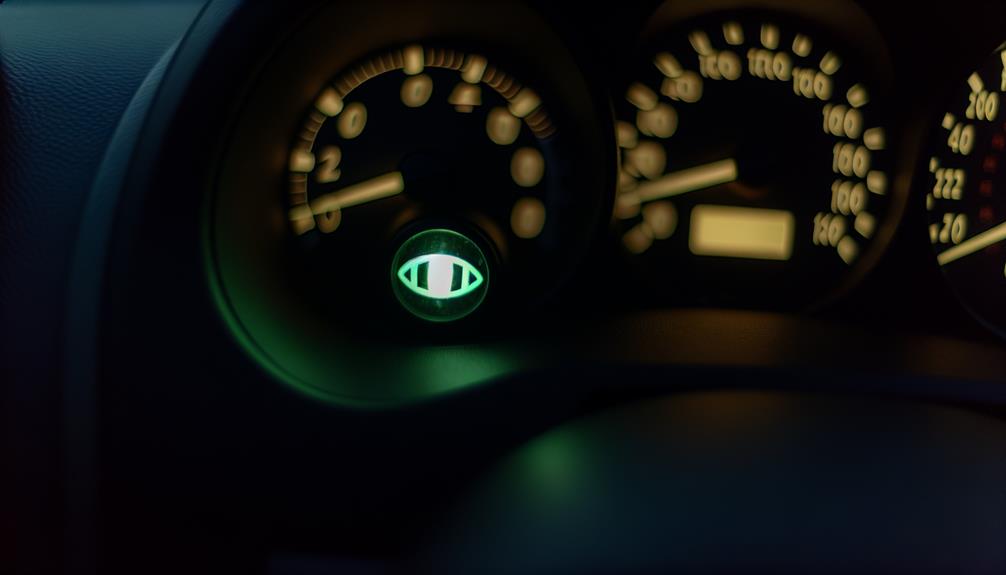
Key Takeaways
- The fog light symbol resembles a headlamp with three horizontal lines intersected by a wavy vertical line.
- Typically located on the dashboard or the light control panel for easy identification.
- Fog lights should be used in poor visibility conditions like fog, mist, heavy rain, or snow.
- Differentiate fog light symbols from standard headlight indicators to avoid misuse.
- Legal regulations often require using fog lights only in reduced visibility conditions to ensure safety.
Identifying the Fog Light Symbol
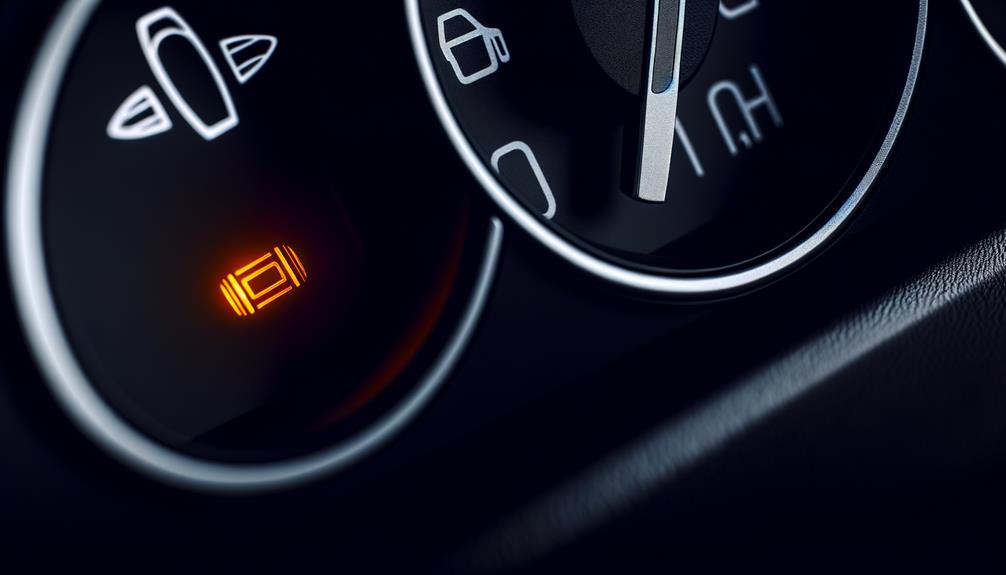
To identify the fog light symbol, look for an icon on your vehicle's dashboard that resembles a headlamp with three horizontal lines intersected by a wavy vertical line. This symbol is a standardized representation used internationally to indicate the activation of fog lights.
Understanding this symbol is essential for best vehicle operation, especially in low-visibility conditions. Fog lights are designed to enhance visibility during adverse weather conditions such as fog, rain, or snow, thereby improving road safety.
Recognizing this symbol allows drivers to utilize their vehicle's safety features effectively. It is typically found on the dashboard or the light control panel, ensuring drivers can quickly and accurately identify when their fog lights are engaged.
Types of Fog Lights
Fog lights can be broadly categorized into front fog lights and rear fog lights, each serving distinct purposes to enhance vehicle visibility under adverse weather conditions. Front fog lights are mounted low on the vehicle's front bumper to project a wide, bar-shaped beam that cuts through fog, mist, or heavy rain, minimizing reflection and glare.
Rear fog lights, on the other hand, emit a powerful red light to alert drivers behind of reduced visibility conditions, thereby preventing rear-end collisions. Both types are critical for ensuring safety during poor weather and low-visibility scenarios.
The integration of these specialized lights into modern automotive design reflects advancements in vehicle safety engineering and regulatory compliance.
Dashboard Light Indicators
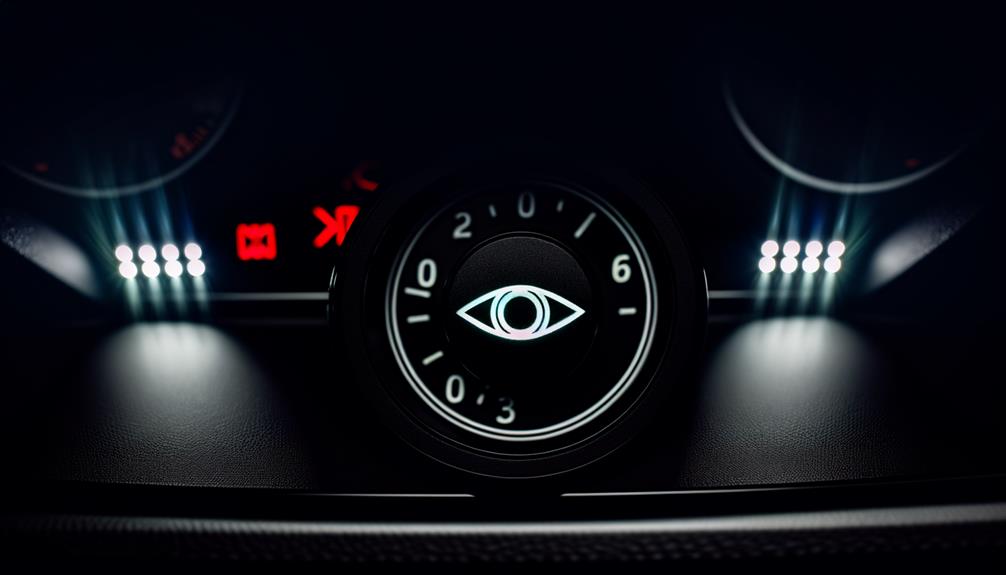
Dashboard light indicators serve as critical tools for informing drivers about the operational status and potential issues within their vehicle. Understanding the common warning indicators, the significance of their colors, and the necessary action steps can help maintain vehicle safety and performance.
This section will explore these key aspects to enhance driver awareness and response.
Common Warning Indicators
Understanding the various warning indicators on a vehicle's dashboard is essential for ensuring proper maintenance and safety. Common warning indicators include the check engine light, oil pressure warning, and battery alert.
The check engine light signifies potential issues within the engine, necessitating diagnostic evaluation. The oil pressure warning indicates low oil pressure, which could result in severe engine damage if ignored. The battery alert highlights issues with the vehicle's charging system, potentially leading to a stalled engine.
Other critical indicators encompass the brake warning light, signaling brake system malfunctions, and the temperature warning light, which denotes engine overheating. Recognizing these indicators promptly allows drivers to address underlying issues swiftly, ensuring vehicle reliability and safety.
Color Significance Explained
Building on the knowledge of common warning indicators, understanding the color significance of dashboard light indicators is essential for accurately interpreting the urgency and nature of vehicle alerts. Dashboard lights typically employ a color-coded system: red, amber, and green.
Red lights indicate critical issues requiring immediate attention, such as engine overheating or brake system failure.
Amber or yellow lights signify cautionary alerts, advising the driver to inspect potential issues soon, like low fuel or tire pressure warnings.
Green or blue lights generally represent active systems, such as headlights or cruise control, and do not require immediate action.
Mastery of this color-coding system enhances a driver's ability to maintain vehicle health and safety efficiently.
Action Steps Required
When a dashboard light indicator is activated, the first step is to assess the color to determine the urgency and appropriate response required. Different colors signify various levels of immediacy:
| Color | Action Steps Required |
|---|---|
| Red | Stop immediately; check issue |
| Yellow/Amber | Proceed with care; seek service soon |
| Green/Blue | Informational; no direct action |
For instance, a red fog light symbol necessitates stopping and examining the fog lights for malfunction, whereas a yellow indicator suggests scheduling a maintenance visit. Green or blue symbols merely indicate operational status, requiring no immediate involvement. Understanding these distinctions guarantees timely and accurate responses, enhancing vehicle safety and performance.
When to Use Fog Lights
Fog lights should be utilized primarily during conditions of poor visibility such as heavy fog, dense mist, or severe rain. These specialized lights are designed to enhance road illumination and improve safety under challenging weather conditions.
Key scenarios for their use include:
- Heavy Fog: When visibility drops below 100 meters, fog lights provide enhanced roadway illumination.
- Dense Mist: In misty conditions where headlights may reflect light back at the driver, fog lights offer a clearer path.
- Severe Rain: During torrential downpours, fog lights help cut through the rain, making the road ahead more visible.
- Snowstorms: In heavy snowfall, fog lights reduce glare and improve visibility, offering better control and safety.
Proper use of fog lights is essential for best driving safety.
Benefits of Fog Lights

Fog lights offer essential benefits by enhancing visibility in low-visibility conditions such as fog, rain, or snow, thereby providing a clearer view of the road ahead.
This improved visibility directly translates to increased driving safety, reducing the likelihood of accidents.
Consequently, fog lights are an essential feature for ensuring secure and effective vehicle operation in adverse weather conditions.
Enhanced Visibility in Fog
By reducing glare greatly and illuminating the road ahead, fog lights are essential for maintaining ideal visibility during adverse weather conditions. This specialized lighting significantly enhances a driver's ability to navigate safely through foggy environments.
The benefits of using fog lights for enhanced visibility can be quantified as follows:
- Glare Reduction: By directing light downwards and away from the driver's line of sight, fog lights minimize reflective glare from the fog.
- Better Road Illumination: Fog lights cast a wider and shorter beam, effectively lighting up the road surface and edges.
- Improved Contrast: Enhances the contrast in low-visibility conditions, helping drivers to discern obstacles and lane markings.
- Adaptive Technology: Modern fog lights often integrate with vehicle systems to adjust intensity based on real-time conditions.
Increased Driving Safety
Incorporating fog lights into a vehicle greatly enhances driving safety by providing superior illumination and reducing the risk of accidents in adverse weather conditions. Fog lights are designed to emit a wide, bar-shaped beam that cuts through fog, rain, and snow, illuminating the road surface more effectively than standard headlights.
This enhanced visibility helps drivers detect obstacles, road markings, and other vehicles sooner, allowing for quicker reaction times. Additionally, the strategic placement of fog lights—typically lower on the vehicle—minimizes glare and prevents light from reflecting back at the driver, further improving visibility.
Industry data consistently shows that vehicles equipped with fog lights experience fewer weather-related accidents, underscoring their critical role in ensuring safer driving conditions.
How to Turn On Fog Lights
Activating your vehicle's fog lights typically involves locating the dedicated switch or control on the dashboard or the multifunction lever. Here's a step-by-step guide for efficient operation:
- Identify the Fog Light Symbol: Look for the fog light symbol, usually depicted as a lamp with lines through it, on the dashboard or multifunction lever.
- Turn on Headlights: Make sure your main headlights are on; fog lights usually only operate in conjunction with the low beam headlights.
- Engage the Fog Light Switch: Rotate or press the designated fog light switch to activate the fog lights.
- Check Indicator Light: Verify that the fog light indicator on the dashboard is illuminated, confirming the fog lights are active.
Common Misconceptions
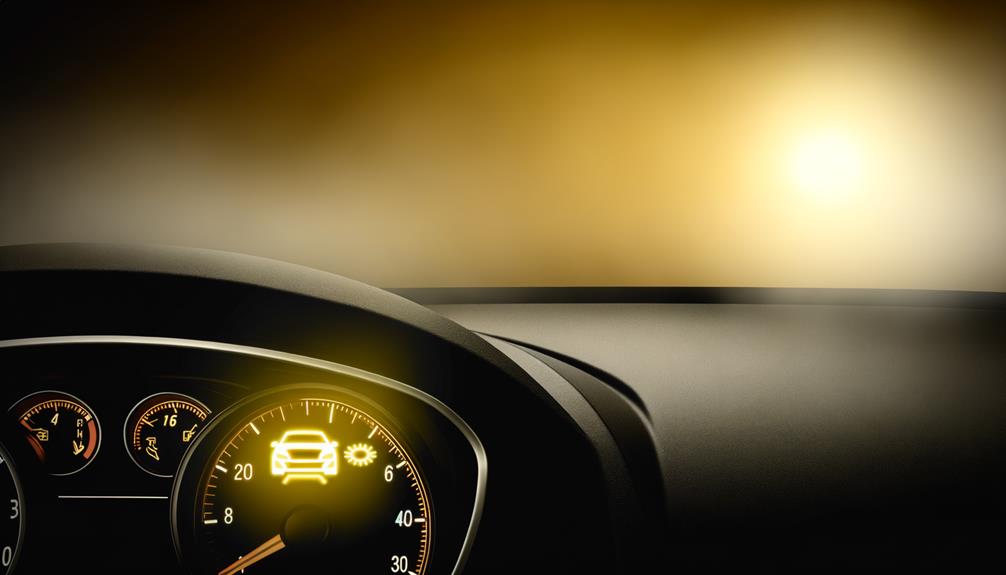
Common misconceptions about fog light symbols often include:
- Misinterpreted dashboard indicators, confusing them with standard headlights.
- Improper usage in clear weather conditions.
These errors can lead to suboptimal visibility and increased risk on the road.
Understanding these misconceptions is essential for ensuring safe and effective use of fog lights.
Misinterpreted Dashboard Indicators
Many drivers often misinterpret dashboard indicators, leading to confusion and potential safety issues. This misunderstanding can result in improper vehicle operation or delayed maintenance.
Below are common misinterpretations:
- Check Engine Light: Often mistaken as a minor issue, this indicator can signify serious engine problems requiring immediate attention.
- Brake Warning Light: Some drivers confuse this with the parking brake indicator, potentially ignoring essential brake system faults.
- Tire Pressure Monitoring System (TPMS): Misinterpreted as a minor alert, low tire pressure can adversely affect vehicle handling and fuel efficiency.
- Oil Pressure Warning: Often misunderstood as a signal for an oil change, this indicator actually warns of low oil pressure, which can lead to engine damage.
Understanding these indicators is vital for maintaining vehicle safety and performance.
Confusing With Headlights
A common misunderstanding among drivers is the mix-up between fog light symbols and standard headlight indicators on the dashboard. This confusion can lead to improper usage, compromising both visibility and safety.
Fog light symbols typically feature an icon resembling a lamp with three wavy lines, indicating light dispersion in foggy conditions. In contrast, headlight indicators often depict a simple lamp or high-beam symbol. Understanding these distinctions is essential for best vehicle operation, especially in adverse weather.
Misidentifying these symbols can result in insufficient lighting or excessive glare for other drivers. As automotive technology progresses, manufacturers are working to design more user-friendly dashboards to minimize such errors and enhance overall driving safety.
Misuse in Clear Weather
While understanding the distinction between fog light symbols and headlight indicators is fundamental, it is equally important to address the frequent misuse of fog lights in clear weather, which can lead to unnecessary glare and distraction for other drivers.
This misuse often stems from common misconceptions:
- Enhanced Visibility: Drivers may believe fog lights improve visibility in clear weather, but their beam pattern is designed specifically for low-visibility conditions.
- Aesthetic Appeal: Some individuals use fog lights for stylistic reasons, unaware of the potential hazards.
- Misunderstanding Controls: Drivers might inadvertently activate fog lights, confusing them with auxiliary lights.
- Lack of Awareness: There is often insufficient driver education regarding the appropriate use of fog lights, leading to widespread misuse.
Addressing these issues can foster safer driving practices.
Legal Requirements
Understanding the legal requirements for fog light usage is essential for promoting compliance with traffic regulations and enhancing road safety. Regulations vary by jurisdiction but typically mandate the use of fog lights only in conditions of reduced visibility, such as fog, heavy rain, or snow.
Misuse of fog lights in clear weather can result in fines and penalties. Specific laws often dictate that fog lights should be turned off once visibility improves to prevent glare for other drivers. Compliance not only avoids legal repercussions but also minimizes the risk of accidents caused by improper lighting.
It is advisable to familiarize oneself with local traffic laws regarding fog light operation to promote adherence and encourage safer driving practices.
Maintenance Tips
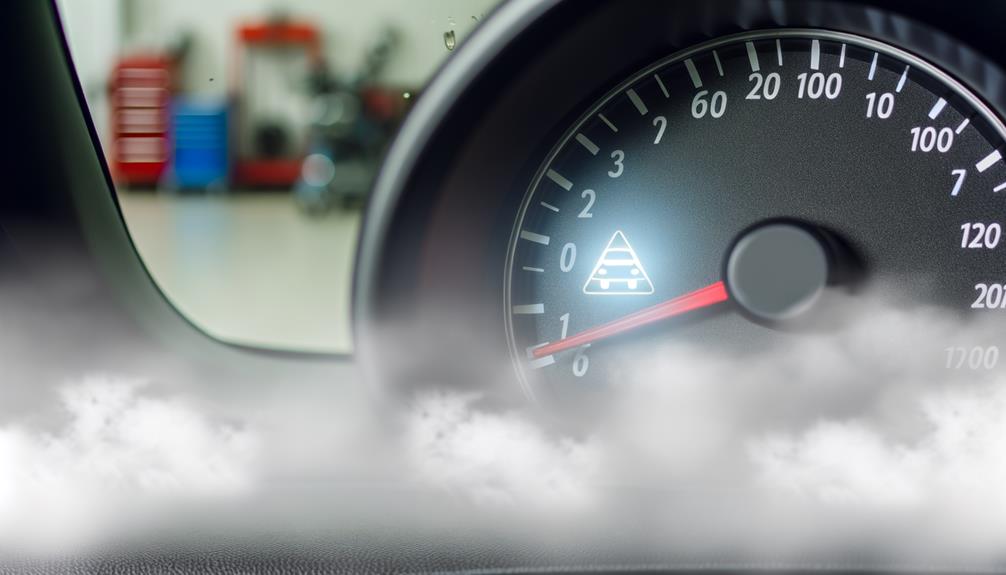
Proper maintenance of fog lights is essential for maintaining their top performance and durability, particularly given the strict legal requirements surrounding their use. To maintain peak functionality, consider the following expert tips:
- Regular Cleaning: Make sure the fog light lenses are clean to maximize visibility. Accumulated dirt and grime can greatly reduce their effectiveness.
- Check Alignment: Periodically inspect and adjust the alignment of the fog lights to ensure they are correctly aimed, preventing glare for other drivers.
- Bulb Replacement: Replace fog light bulbs as soon as they dim or burn out. Using high-quality bulbs can prolong the lifespan and improve performance.
- Inspect Wiring: Routinely examine the wiring for any signs of wear or damage, as faulty wiring can lead to malfunctioning lights.
Following these maintenance practices guarantees compliance and enhances safety.
Fog Light Safety Tips
How can you guarantee maximum security when using fog lights in adverse weather conditions?
To achieve peak visibility and safety, activate fog lights only when visibility is severely compromised, such as during heavy fog, snow, or rain.
Position your fog lights correctly; they should aim low to prevent glare and effectively illuminate the road.
Always use fog lights in conjunction with your low-beam headlights, never alone, to maintain proper lighting balance.
Regularly inspect and clean your fog lights to make sure they are free from dirt and functioning correctly.
Additionally, be mindful of other drivers; turn off fog lights when conditions improve to avoid dazzling oncoming traffic.
Employ these practices to enhance road safety and visibility during adverse weather conditions.
Upgrading Your Fog Lights
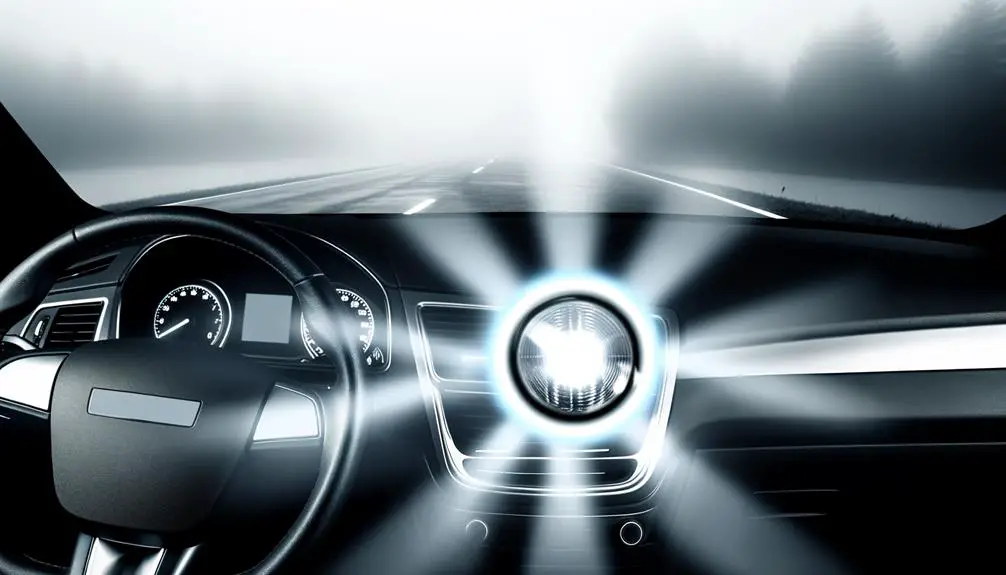
Enhancing your vehicle's fog lights can significantly improve visibility and safety during adverse weather conditions, providing an advantage over standard factory-installed options.
Upgrading your fog lights involves several key considerations:
- Light Source: LED and HID bulbs offer superior brightness and longevity compared to traditional halogen bulbs. LEDs are particularly energy-efficient and have a quicker response time.
- Beam Pattern: Opt for fog lights with a wide, low beam pattern to ensure peak road illumination without dazzling other drivers.
- Color Temperature: Cooler color temperatures (around 6000K) penetrate fog better, improving visibility.
- Compatibility: Make sure that the upgraded lights are compatible with your vehicle's electrical system and mounting points.
These factors collectively contribute to a more efficient and dependable fog light system, enhancing driving safety in challenging conditions.
Conclusion
The significance of fog lights in automotive safety cannot be overstated. A thorough understanding of fog light symbols, types, and dashboard indicators enhances driver preparedness.
Proper usage, adherence to legal requirements, and routine maintenance optimize performance and safety. The potential for upgraded fog lights to offer enhanced visibility further underscores the importance of this often-overlooked vehicle feature.
The theory that superior fog lights contribute to overall road safety is substantiated by empirical evidence, making them indispensable in adverse weather conditions.





